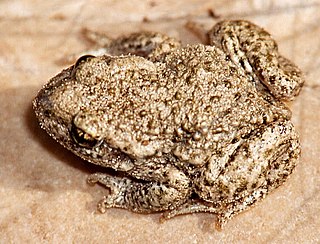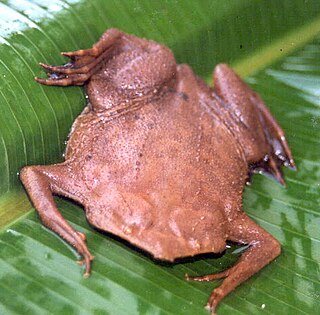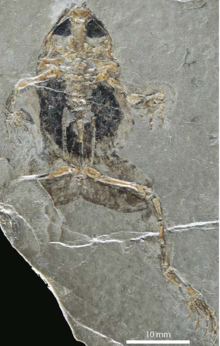
The Alytidae are a family of primitive frogs. Their common name is painted frogs or midwife toads. Most are endemic to Europe, but three species occur in northwest Africa, and a species formerly thought to be extinct is found in Israel.

The Pipidae are a family of primitive, tongueless frogs. There are 41 species in the family, found in tropical South America and sub-Saharan Africa.

Nemegtosaurus was a sauropod dinosaur from the Late Cretaceous Period of what is now Mongolia. It was named after the Nemegt Basin in the Gobi Desert, where the remains — a single skull — were found. The skull resembles diplodocoids in being long and low, with pencil-shaped teeth. However, recent work has shown that Nemegtosaurus is in fact a titanosaur, closely related to animals such as Saltasaurus, Alamosaurus and Rapetosaurus.

Beelzebufo is a particularly large species of prehistoric frog described in 2008. Common names assigned by the popular media include devil frog, devil toad, and the frog from hell.

Notobatrachus is an extinct genus of frog from the Lower Jurassic (Toarcian) Cañadon Asfalto Formation, Cañadón Asfalto Basin and Middle Jurassic La Matilde Formation, Deseado Massif of Patagonia, Argentina. N. degiustoi is the most completely known Jurassic frog and has been recorded in many outcrops of the La Matilde Formation of the Deseado Massif in southern Patagonia.
Avitabatrachus uliana is the only species discovered so far in the extinct genus Avitabatrachus, a genus of prehistoric frogs that lived in the Middle Cretaceous. Fossils of A. uliana were found in the Candeleros Formation of northwestern Patagonia in Argentina. It was properly described in 2000 and was then concluded to be most closely related to Pipidae frogs. Hence, it was included in Pipimorpha.
Baurubatrachus is an extinct genus of prehistoric frogs found in the Maastrichtian Marília Formation of Brazil, formerly considered to be related to the extant family Ceratophryidae. However, a detailed assessment of the anatomy and relationships of the single known fossil of Baurubatrachus demonstrated that it is not part of Ceratophryidae and might be part of a much ancient group of Neobatrachia.
Nevobatrachus gracilis is the only species in the extinct genus Nevobatrachus, a genus of prehistoric frogs. The original generic name of this frog was Cordicephalus Nevo (1968); however, this generic name turned out to be preoccupied by a cestode genus Cordicephalus Wardle, McLeod & Stewart (1947), which remains nomenclaturally available in spite of being considered a junior synonym of the diphyllobothriid genus Pyramicocephalus. Mahony (2019) coined a replacement name Nevobatrachus. Fossils of N. gracilis were found in a lacustrine deposit in Makhtesh Ramon called "Amphibian Hill" and it is believed they lived during the Lower Cretaceous.

Neusibatrachus is an extinct genus of frog, known from the Early Cretaceous (Barremian) La Pedrera de Rúbies Formation of Spain. It is one of the oldest representatives of Pipimorpha.

Liaoxitriton is an extinct genus of prehistoric cryptobranchoid salamanders from the Early Cretaceous of China. It contains one species, L. zhongjiani, from the Aptian aged Yixian Formation. A second species, L. daohugouensis from the Middle/Late Jurassic Daohugou Beds, was moved to the genus Neimengtriton in 2021 after a number of studies noted morphological differences between the two genera.
Wealdenbatrachus is an extinct genus of prehistoric frog known from the Lower Cretaceous of Uña, Spain, which is part of the La Huérguina Formation Its anatomy and relationships have recently been revisited, finding that this frog might be a proficient jumper, and that it was a primitive frog close to the ancestry of all modern frogs.

Singidella is an extinct genus of prehistoric frog from the Eocene of Tanzania. There is currently only one described species, S. latecostata. Its generic name is derived from Singida, the city near which the only known specimens were found, and the specific name translates as "wide ribs" from Latin. It is a member of the family Pipidae and is closely related to the extant African dwarf frogs (Hymenochirus) and Merlin's dwarf gray frog (Pseudohymenochirus) and the Cretaceous frog Pachycentrata of Niger. Adult indiviuals were estimated at 41-45 mm in length from snout to vent.
Thoraciliacus rostriceps is an extinct species of frog from the Cretaceous period and the only species of the genus Thoraciliacus, which is classified in the unranked clade Pipimorpha. Fossils of T. rostriceps were found in Makhtesh Ramon, Negev Desert, Israel and it is believed they lived during the Barremian. Other fossils have been found near Marydale, South Africa in an Upper Cretaceous lake.

Pipoidea are a clade of frogs, that contains the most recent common ancestor of living Pipidae and Rhinophrynidae as well as all its descendants. It is broadly equivalent to Xenoanura.
Cratia is an extinct frog which existed in Brazil during the Early Cretaceous (Aptian). Fossils were discovered in and named after the Crato Formation. It was named by Ana M. Báez, Geraldo J.B. Moura and Raúl O. Gómez in 2009, and the type species is Cratia gracilis.
Eurycephalella is an extinct genus of frogs which existed in what is now Brazil during the Early Cretaceous (Aptian). It was named by Ana M. Báez, Geraldo J.B. Moura and Raúl O. Gómez in 2009, and the type species is Eurycephalella alcinae.

Rhinella loba is an extinct true toad that inhabited the South American Pampas during the late Pliocene. It is closely related to the present day Argentine toad Rhinella arenarum and represents to date the only diagnosable extinct true toad species from South America.
This list of fossil amphibians described in 2018 is a list of new taxa of fossil amphibians that were described during the year 2018, as well as other significant discoveries and events related to amphibian paleontology that occurred in 2018.
Kawasphenodon is an extinct genus of sphenodontian reptile, known from the Late Cretaceous and Paleocene of Patagonia in South America. The type species, K. expectatus, was described in 2005 from jaw fragments found in late Campanian aged sediments in the Los Alamitos Formation, the jaw when complete was estimated to be 11 cm long, making it among the largest known sphenodontians. A second species, K. peligrensis, around 1/3 the size of the type species, was described in 2014 also from jaw fragments in early Paleocene (Danian) sediments of the Salamanca Formation, making it the youngest known definitive representative of Rhynchocephalia outside of New Zealand. In the original description, it was found to be a member of Sphenodontidae, in some other subsequent analyses it was found to be a member of Opisthodontia. A 2020 analysis of rhyncocephalian relationships found it to be outside Opisthodontia, and instead a member of the Sphenodontinae as the closest known relative of the tuatara, with an estimated divergence between the two genera in the Early Cretaceous. Other subsequent studies have endorsed its placement as a member of Sphenodontidae. Like most other rhynchocephalians, the teeth are acrodont, with a deep dentary, and it probably had an omnivorous habit.










